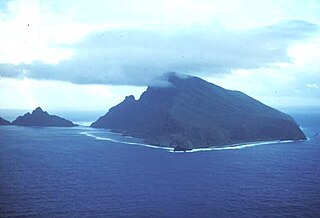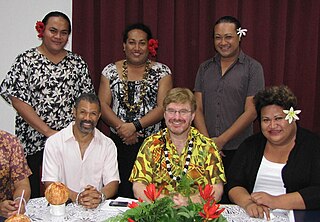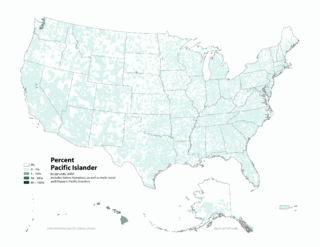
Samoa, officially the Independent State of Samoa and known until 1997 as Western Samoa, is an island country in Polynesia, consisting of two main islands ; two smaller, inhabited islands ; and several smaller, uninhabited islands, including the Aleipata Islands. Samoa is located 64 km (40 mi) west of American Samoa, 889 km (552 mi) northeast of Tonga, 1,152 km (716 mi) northeast of Fiji, 483 km (300 mi) east of Wallis and Futuna, 1,151 km (715 mi) southeast of Tuvalu, 519 km (322 mi) south of Tokelau, 4,190 km (2,600 mi) southwest of Hawaii, and 610 km (380 mi) northwest of Niue. The capital and largest city is Apia. The Lapita people discovered and settled the Samoan Islands around 3,500 years ago. They developed a Samoan language and Samoan cultural identity.

Apia is the capital and only city of Samoa. It is located on the central north coast of Upolu, Samoa's second-largest island. Apia falls within the political district (itūmālō) of Tuamasaga.

Samoan is a Polynesian language spoken by Samoans of the Samoan Islands. Administratively, the islands are split between the sovereign country of Samoa and the United States territory of American Samoa. It is an official language, alongside English, in both jurisdictions. It is widely spoken across the Pacific region, heavily so in New Zealand and also in Australia and the United States. Among the Polynesian languages, Samoan is the most widely spoken by number of native speakers.

Territories of the United States are sub-national administrative divisions and dependent territories overseen by the federal government of the United States. The American territories differ from the U.S. states and Indian reservations as they are not sovereign entities. In contrast, each state has a sovereignty separate from that of the federal government and each federally recognized Native American tribe possesses limited tribal sovereignty as a "dependent sovereign nation". Territories are classified by incorporation and whether they have an "organized" government through an organic act passed by the Congress. American territories are under American sovereignty and may be treated as part of the U.S. proper in some ways and not others. Unincorporated territories in particular are not considered to be integral parts of the U.S., and the U.S. Constitution applies only partially in those territories.

The Samoan Islands are an archipelago covering 3,030 km2 (1,170 sq mi) in the central South Pacific, forming part of Polynesia and of the wider region of Oceania. Administratively, the archipelago comprises all of the Independent State of Samoa and most of American Samoa. The land masses of the two Samoan jurisdictions are separated by 64 km of ocean at their closest points.

The Samoa national rugby union team represents the Samoa Rugby Union in men's international rugby union. They are also known as "Manu Samoa", which is thought to derive from the name of a Samoan warrior. They perform a traditional Samoan challenge called the siva tau before each game. Samoa Rugby Union were formerly members of the Pacific Islands Rugby Alliance (PIRA) along with Fiji and Tonga. They are ranked 11th in the world.

Samoans or Samoan people are the Indigenous Polynesian people of the Samoan Islands, an archipelago in Polynesia, who speak the Samoan language. The group's home islands are politically and geographically divided between the Independent State of Samoa and American Samoa, an unincorporated territory of the United States of America. Though divided by national border, the culture and language are the same.

Faʻafafine are natal males who align with a third gender or gender role in Samoa. Fa'afafine are not assigned the role at birth, nor raised as girls due to a lack of daughters, as is often claimed in western media. Rather, their femininity emerges in early childhood, and Samoans recognize them as distinct from typical boys.

Pacific Islander Americans are Americans who are of Pacific Islander ancestry. For its purposes, the United States census also counts Aboriginal Australians as part of this group.

Gracillariidae is an important family of insects in the order Lepidoptera and the principal family of leaf miners that includes several economic, horticultural or recently invasive pest species such as the horse-chestnut leaf miner, Cameraria ohridella.

American Samoa is an unincorporated territory of the United States located in the Polynesia region of the South Pacific Ocean. Centered on 14.3°S 170.7°W, it is 40 miles (64 km) southeast of the island country of Samoa, east of the International Date Line and the Wallis and Futuna Islands, west of the Cook Islands, north of Tonga, and some 310 miles (500 km) south of Tokelau. American Samoa is the southernmost territory of the United States, situated 2,200 miles (3,500 km) southwest of the U.S. state of Hawaii, and one of two U.S. territories south of the Equator, along with the uninhabited Jarvis Island.

Conopomorpha cramerella, the cocoa pod borer, is a moth of the family Gracillariidae. It is known from Saudi Arabia, China, India, Thailand, Brunei, Indonesia, Malaysia, Vietnam, Australia, New Britain, the Philippines, Samoa, the Solomon Islands, Sri Lanka, Vanuatu, and Australia.
Acrocercops brachyglypta is a moth of the family Gracillariidae, known from Java, Indonesia, as well as Samoa and the Solomon Islands. It was described by E. Meyrick in 1931.
Macarostola pyrelictis is a moth of the family Gracillariidae. It is known from Samoa.
Caloptilia chrysochoa is a moth of the family Gracillariidae. It is known from Samoa and Tonga.
Acrocercops strophala is a moth of the family Gracillariidae. It is commonly found in India, Indonesia (Java), Samoa, Guadalcanal and Sri Lanka.
Acrocercops homalacta is a moth of the family Gracillariidae, known from Guadalcanal and Rennell Island in the Solomon Islands, as well as Samoa. It was described by Edward Meyrick in 1927.
Acrocercops phaeodeta is a moth of the family Gracillariidae, known from Samoa. It was described by Edward Meyrick in 1927.
Acrocercops nebropa is a moth of the family Gracillariidae, known from Samoa. It was described by Edward Meyrick in 1932.

Gracillariinae are a subfamily of moths which was described by Henry Tibbats Stainton in 1854.












